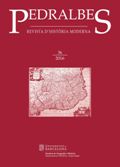Mariana Victoria de Portugal: una infanta y muchas cartas
Keywords:
Maria Victoria, Isabel Farnesio, Joseph I of Portugal, palace etiquette, Lisbon earthquake, treatise of San Ildefonso.Abstract
The correspondence that Maria Victoria (Madrid, 1718–Lisbon, 1781) held with her mother, queen Isabel Farnesio, between 1729 and 1766 (year of the latter’s death) and then with her brothers, permits a detailed knowledge of the upbringing, pastimes and marital life of the infanta in Madrid, Paris and Lisbon. Destined as early as 1721 to marry Louis XV of France, his new matrimonialplans brought her to marry the future Joseph I of Portugal in 1732. Together with details of her pregnancies and the birth of her daughters, Portuguese etiquette, gifts interchanged, her entourage and ladies in waiting and other palace features, Maria Victoria’s letters echoed, as a background, the main events of those years: the difficult relations between Spain and Portugal concerning their borders in South America, administrative reforms by the count
of Oeiras, the Lisbon earthquake of 1755, the Marquis of Pombal’s rise to power. More particularly, the attempt on Joseph’s life in 1758 opened the way for her to be appointed governess for two months, while in 1776-1777 she acted as regent. Later, and as a widower, she visited Spain. The correspondence sheds light on the learned infanta and queen, who loved horsemanship and music, a queen of the Enlightenment.
Downloads
Published
How to Cite
Issue
Section
License
Copyright (c) 2016 Mª Victoria López-Cordón Cortezo

This work is licensed under a Creative Commons Attribution-ShareAlike 4.0 International License.
Authors must agree with the following terms:
1. The author keeps authorship rights, ceding the journal the right to first publication.
2. Texts will be disseminated with a Creative Commons Attribution 4.0 International License. Which allows for the work to be shared with third parties, as long as they recognise the work’s authorship, the original publication in the journal and licensing conditions.
This requires acknowledging authorship appropriately, providing a link to the license, and indicating if any changes have been made. It can be indicated in any reasonable way, but not in a manner that suggests the licensor endorses or sponsors the use of the text.
If content is remixed, transformed, or new content is created from the journal's texts, it must be distributed under the same license as the original text



